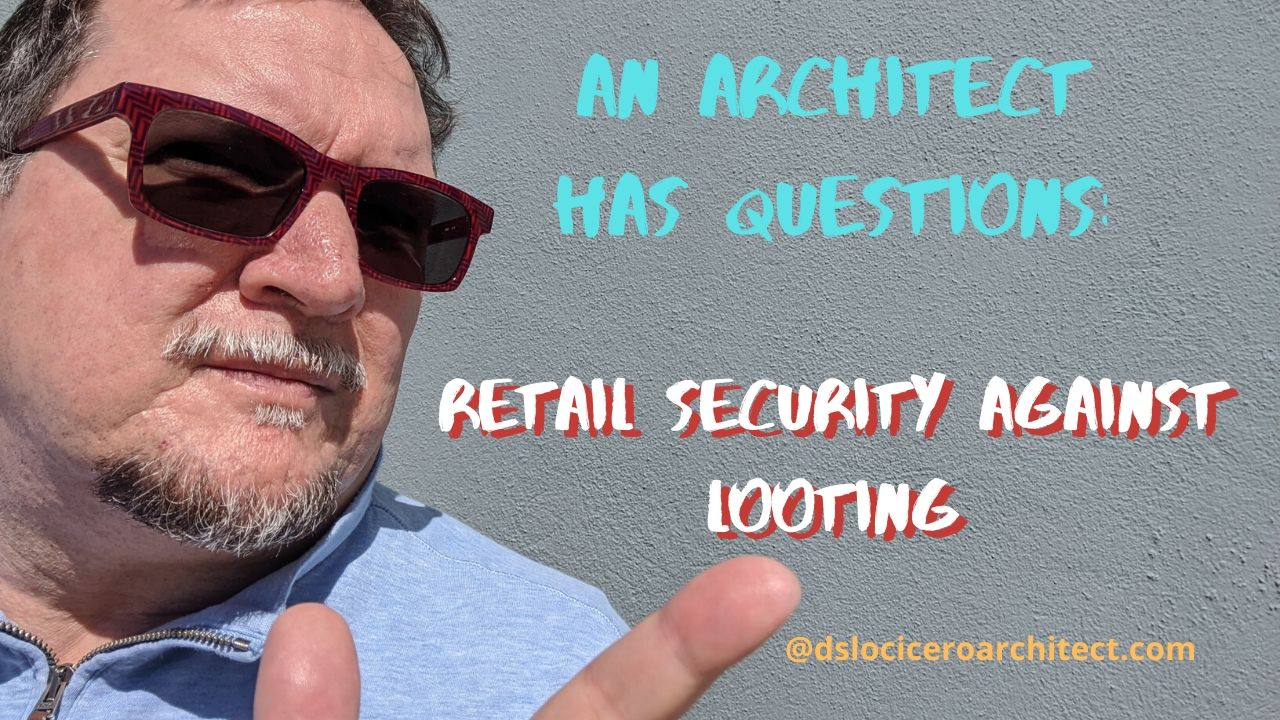On May 30, 2020, for shopping centers in Emeryville, California were looted in the unrest that followed the murder of George Floyd, an unarmed African American man at the hands of the police. On the morning of the 31st, I walked through two of the centers to see what kind of damage had been done.
This video documents some of what I saw and my initial thoughts and questions about how architects can help prevent or minimize the damage from vandals and looters.
The Dilemma
Retailers like to have as much glass as possible so shoppers can see into the stores and be enticed by what they see.
Looters and vandals like to see as much glass as possible because it makes it easier to break into a store.
We might reduce the amount of glass in the store front. That usually doesn’t work for the retailer.
The solution is to use different ways to make it harder to get through the glass and into the store. We want to achieve what the retailer wants while making it more difficult for thieves, vandals, and looters to gain entry. Here is how to do that.
Glass Types
The first thing that I noticed is that only one of the stores appeared to have used laminated safety glass. All the stores that suffered the worst damage and the most extensive looting had used normal glass and tempered safety glass.
The looters were somewhat consistent about breaking the tempered safety glass to gain entry to those stores without security gates. Tempered safety glass breaks into small pieces with rounded corners and when broken are less likely to cause injuries.
Laminated safety glass has a layer of transparent plastic sandwiched between two layers of glass. When the window is broken, the plastic holds the glass in place. If you use tempered safety glass in the lamination, the result is even safer.
It is not impossible to get through laminated safety glass, but it takes longer and more effort.
Security Gates
The second thing I noticed is that not all security gates are created equal. I am not an expert in security gates. I cannot say if the gates that failed did so because the gate was flawed, or if the installation was flawed.
It was apparent, however, that some gates held up. And others did not.
The gates which appeared to be solid seemed to hold up best.
Structure
Thirdly, the store where it appeared the storefront had been rammed by a car or truck had the solid type of gates. I suspect that the storefront was rammed in order to dislodge the gates. Which it did.
If the opening had had some steel structural framing in the storefront system, there would have been more resistance to the vehicular damage, and the store may have been less likely to have been breached.
Recommendations
Based solely on my observations, I would recommend that retail shop owners invest in the following – after basic locks and alarms:
- Use laminated safety glass in both the doors and the windows. It costs more to install, but what is the value of your merchandise? What is the cost if you have to replace it all on top of repairing damage to the store? This is the least expensive of my recommendations.
- Invest in a solid appearing security gate. Put the gate as close to the store front windows as possible. Ensure that the tracks that the gate glide in are not within easy reach of the edge of the store front. (Meaning the gate should extend at least 6 inches or more past the edge of the widow.) Ensure that the gate is securely anchored to structural members. Gates are the next step to take.
- If you have large expanses of glass storefront, perhaps breaking that up into sections of less than 5 feet with structural steel columns that attach to both the foundation and the header above the window opening, or even extending to the underside of the roof. This will reduce the probability of vehicles being able to ram through the store front.
Most of my practice focuses on residential work: new homes, accessory dwellings, additions, and remodeling. But I started my architectural career working in an office where we designed shopping centers and military research facilities. I also worked for an office that designed an American embassy building and science facilities that were subject to frequent protests.
If you are a retailer who has some questions about either rebuilding or hardening a future facility against potential damage, you can make an appointment with me by clicking on the scheduling button on the right side of this page.





